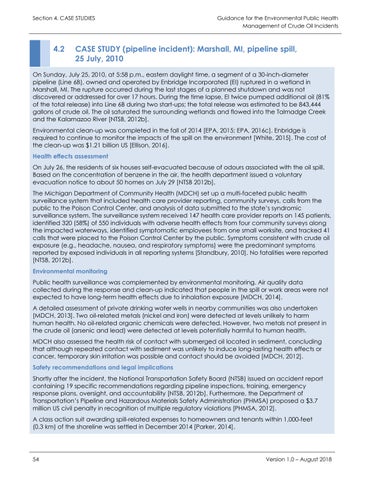Section 4. CASE STUDIES
4.2
Guidance for the Environmental Public Health Management of Crude Oil Incidents
CASE STUDY (pipeline incident): Marshall, MI, pipeline spill, 25 July, 2010
On Sunday, July 25, 2010, at 5:58 p.m., eastern daylight time, a segment of a 30-inch-diameter pipeline (Line 6B), owned and operated by Enbridge Incorporated (EI) ruptured in a wetland in Marshall, MI. The rupture occurred during the last stages of a planned shutdown and was not discovered or addressed for over 17 hours. During the time lapse, EI twice pumped additional oil (81% of the total release) into Line 6B during two start-ups; the total release was estimated to be 843,444 gallons of crude oil. The oil saturated the surrounding wetlands and flowed into the Talmadge Creek and the Kalamazoo River [NTSB, 2012b]. Environmental clean-up was completed in the fall of 2014 [EPA, 2015; EPA, 2016c]. Enbridge is required to continue to monitor the impacts of the spill on the environment [White, 2015]. The cost of the clean-up was $1.21 billion US [Ellison, 2016]. Health effects assessment On July 26, the residents of six houses self-evacuated because of odours associated with the oil spill. Based on the concentration of benzene in the air, the health department issued a voluntary evacuation notice to about 50 homes on July 29 [NTSB 2012b]. The Michigan Department of Community Health (MDCH) set up a multi-faceted public health surveillance system that included health care provider reporting, community surveys, calls from the public to the Poison Control Center, and analysis of data submitted to the state’s syndromic surveillance system. The surveillance system received 147 health care provider reports on 145 patients, identified 320 (58%) of 550 individuals with adverse health effects from four community surveys along the impacted waterways, identified symptomatic employees from one small worksite, and tracked 41 calls that were placed to the Poison Control Center by the public. Symptoms consistent with crude oil exposure (e.g., headache, nausea, and respiratory symptoms) were the predominant symptoms reported by exposed individuals in all reporting systems [Standbury, 2010]. No fatalities were reported [NTSB, 2012b]. Environmental monitoring Public health surveillance was complemented by environmental monitoring. Air quality data collected during the response and clean-up indicated that people in the spill or work areas were not expected to have long-term health effects due to inhalation exposure [MDCH, 2014]. A detailed assessment of private drinking water wells in nearby communities was also undertaken [MDCH, 2013]. Two oil-related metals (nickel and iron) were detected at levels unlikely to harm human health. No oil-related organic chemicals were detected. However, two metals not present in the crude oil (arsenic and lead) were detected at levels potentially harmful to human health. MDCH also assessed the health risk of contact with submerged oil located in sediment, concluding that although repeated contact with sediment was unlikely to induce long-lasting health effects or cancer, temporary skin irritation was possible and contact should be avoided [MDCH, 2012]. Safety recommendations and legal implications Shortly after the incident, the National Transportation Safety Board (NTSB) issued an accident report containing 19 specific recommendations regarding pipeline inspections, training, emergency response plans, oversight, and accountability [NTSB, 2012b]. Furthermore, the Department of Transportation’s Pipeline and Hazardous Materials Safety Administration (PHMSA) proposed a $3.7 million US civil penalty in recognition of multiple regulatory violations [PHMSA, 2012]. A class action suit awarding spill-related expenses to homeowners and tenants within 1,000-feet (0.3 km) of the shoreline was settled in December 2014 [Parker, 2014].
54
Version 1.0 – August 2018







